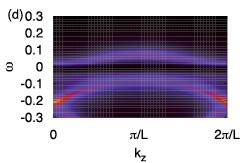Dimensional Crossover in Layered f-Electron Superlattices
Oshikawa Group
Dimensionality plays a crucial role in condensed matter physics, especially in systems with strong interactions. Layered structures provide an opportunity to control the dimensionality and to observe effects of reduced dimensionality and crossover behavior between two and three dimensions. In particular, recent successful fabrications of the layered superlattices of CeIn3/LaIn3 [1] and CeCoIn5/YbCoIn5 [2] have opened new possibilities for investigating such phenomena in f-electron systems. In these systems, the f-electrons are present only in the Ce layers, which are 2-dimensional. These systems exhibit antiferromagnetic or superconducting long-range order in regions of the phase diagram, which implies a dimensional crossover to 3 dimensions. These observations also give rise to an even more fundamental question on the dimensionality of the heavy electron states, before formation of any order. Existing theories on these systems have been based on the assumption that the f-electrons, separated by the spacer layers, are almost decoupled, which results in essentially 2-dimensional heavy electron states.

Fig. 1. Electron spectral function in a layered f-electron superlattice as a function of the momentum component kz perpendicular to the layers, at a low temperature with fixed in-plane components kx, ky. The dispersion along the z-axis implies formation of heavy electron states extending over the entire system, coupled through the spacer layers which do not have f-electrons.
We reexamined [3] the heavy electron states in the layered f-electron superlattices, based on the inhomogeneous dynamical mean field theory combined with numerical renormalization group as an impurity solver. We show that the spectral function exhibits formation of heavy electrons in the entire system below a temperature scale T0. On the other hand, in terms of transport, two different coherence temperatures Tx and Tz are identified in the in-plane- and the out-of-plane-resistivity, respectively. Remarkably, we find Tz < Tx ~ T0 due to scatterings between different reduced Brillouin zones. The existence of these two distinct energy scales implies a crossover in the dimensionality of the heavy electrons between two and three dimensions as temperature or layer geometry is tuned. This dimensional crossover would be responsible for the characteristic behaviors in the magnetic and superconducting properties observed in the experiments.
References
- [1] H. Shishido, T. Shibauchi, K. Yasu, T. Kato, H. Kontani, T. Terashima, and Y. Matsuda, Science 327, 980 (2010).
- [2] Y. Mizukami, et al., Nat. Phys. 7, 849 (2012); S. K. Goh, et al., Phys. Rev. Lett. 109, 157006 (2012).
- [3] Y. Tada, R. Peters, and M. Oshikawa, preprint (2013).
